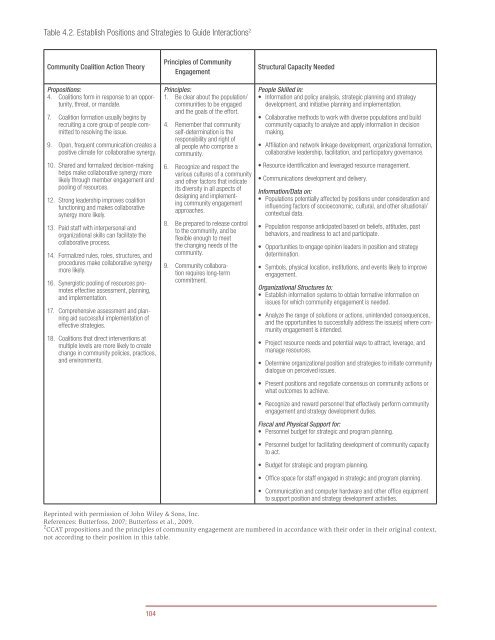Principles of Community Engagement (Second Edition)
Principles of Community Engagement (Second Edition)
Principles of Community Engagement (Second Edition)
You also want an ePaper? Increase the reach of your titles
YUMPU automatically turns print PDFs into web optimized ePapers that Google loves.
Table 4.2. Establish Positions and Strategies to Guide Interactions 2<br />
<strong>Community</strong> Coalition Action Theory<br />
Propositions:<br />
4. Coalitions form in response to an opportunity,<br />
threat, or mandate.<br />
7. Coalition formation usually begins by<br />
recruiting a core group <strong>of</strong> people committed<br />
to resolving the issue.<br />
9. Open, frequent communication creates a<br />
positive climate for collaborative synergy.<br />
10. Shared and formalized decision-making<br />
helps make collaborative synergy more<br />
likely through member engagement and<br />
pooling <strong>of</strong> resources.<br />
12. Strong leadership improves coalition<br />
functioning and makes collaborative<br />
synergy more likely.<br />
13. Paid staff with interpersonal and<br />
organizational skills can facilitate the<br />
collaborative process.<br />
14. Formalized rules, roles, structures, and<br />
procedures make collaborative synergy<br />
more likely.<br />
16. Synergistic pooling <strong>of</strong> resources promotes<br />
effective assessment, planning,<br />
and implementation.<br />
17. Comprehensive assessment and planning<br />
aid successful implementation <strong>of</strong><br />
effective strategies.<br />
18. Coalitions that direct interventions at<br />
multiple levels are more likely to create<br />
change in community policies, practices,<br />
and environments.<br />
104<br />
<strong>Principles</strong> <strong>of</strong> <strong>Community</strong><br />
<strong>Engagement</strong><br />
<strong>Principles</strong>:<br />
1. Be clear about the population/<br />
communities to be engaged<br />
and the goals <strong>of</strong> the effort.<br />
4. Remember that community<br />
self-determination is the<br />
responsibility and right <strong>of</strong><br />
all people who comprise a<br />
community.<br />
6. Recognize and respect the<br />
various cultures <strong>of</strong> a community<br />
and other factors that indicate<br />
its diversity in all aspects <strong>of</strong><br />
designing and implementing<br />
community engagement<br />
approaches.<br />
8. Be prepared to release control<br />
to the community, and be<br />
flexible enough to meet<br />
the changing needs <strong>of</strong> the<br />
community.<br />
9. <strong>Community</strong> collaboration<br />
requires long-term<br />
commitment.<br />
Structural Capacity Needed<br />
People Skilled in:<br />
• Information and policy analysis, strategic planning and strategy<br />
development, and initiative planning and implementation.<br />
• Collaborative methods to work with diverse populations and build<br />
community capacity to analyze and apply information in decision<br />
making.<br />
• Affiliation and network linkage development, organizational formation,<br />
collaborative leadership, facilitation, and participatory governance.<br />
• Resource identification and leveraged resource management.<br />
• Communications development and delivery.<br />
Information/Data on:<br />
• Populations potentially affected by positions under consideration and<br />
influencing factors <strong>of</strong> socioeconomic, cultural, and other situational/<br />
contextual data.<br />
• Population response anticipated based on beliefs, attitudes, past<br />
behaviors, and readiness to act and participate.<br />
• Opportunities to engage opinion leaders in position and strategy<br />
determination.<br />
• Symbols, physical location, institutions, and events likely to improve<br />
engagement.<br />
Organizational Structures to:<br />
• Establish information systems to obtain formative information on<br />
issues for which community engagement is needed.<br />
• Analyze the range <strong>of</strong> solutions or actions, unintended consequences,<br />
and the opportunities to successfully address the issue(s) where community<br />
engagement is intended.<br />
• Project resource needs and potential ways to attract, leverage, and<br />
manage resources.<br />
• Determine organizational position and strategies to initiate community<br />
dialogue on perceived issues.<br />
• Present positions and negotiate consensus on community actions or<br />
what outcomes to achieve.<br />
• Recognize and reward personnel that effectively perform community<br />
engagement and strategy development duties.<br />
Fiscal and Physical Support for:<br />
• Personnel budget for strategic and program planning.<br />
• Personnel budget for facilitating development <strong>of</strong> community capacity<br />
to act.<br />
• Budget for strategic and program planning.<br />
• Office space for staff engaged in strategic and program planning.<br />
• Communication and computer hardware and other <strong>of</strong>fice equipment<br />
to support position and strategy development activities.<br />
Reprinted with permission <strong>of</strong> John Wiley & Sons, Inc.<br />
References: Butterfoss, 2007; Butterfoss et al., 2009.<br />
2<br />
CCAT propositions and the principles <strong>of</strong> community engagement are numbered in accordance with their order in their original context,<br />
not according to their position in this table.

















